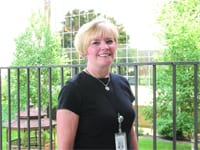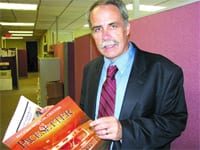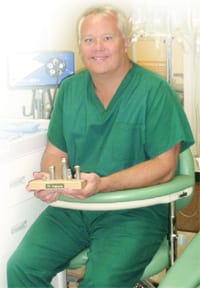The Data Game Electronic Medical Records Begin to Transform Patient Care
Normally, when one thinks of hospitals investing in infrastructure, what comes to mind are actual buildings — and there’s been no shortage of those cropping up across Western Mass. over the past decade.
But area hospitals have also been hard at work building something else: a network of computerized patient information that’s creating a safer environment while streamlining the way providers communicate.
“It’s pretty remarkable what’s transpired over the past decade,” said Mark Gorrell, Baystate Health’s vice president for Information Services. “In the past 10 years, Baystate has invested $122 million into information technology, which represents about 25{06cf2b9696b159f874511d23dbc893eb1ac83014175ed30550cfff22781411e5} of the total capital investment into buildings and everything else.
“Since 2000, the number of users of information systems has quadrupled at Baystate,” he continued. “The IT staff has increased by 40{06cf2b9696b159f874511d23dbc893eb1ac83014175ed30550cfff22781411e5}, and the amount of data that we manage has increased 2,000 times. The cost of maintaining the systems has doubled on an annual basis since 2000. That certainly represents the growth in technology and our investment in the hospital.”
At the heart of this change — which is occurring, to varying degrees, at virtually all hospitals — is something called the electronic medical record, or EMR.
Typically, this is an electronic version of patient information that used to be stored solely in a paper file, but it has other advantages beyond reducing the use of paper.
For example, Gorrell noted, “we have alerts and rules built into electronic medical records to make sure that patients aren’t receiving inappropriate medications based on allergies and drug interactions. This reduces patient harm. And we bar-code patients, and all the medications prescribed and delivered to patients are bar-coded as well. So we’re constantly checking to make sure we have the right patient before delivering any medication.”
Joan Methe, IT director at Mercy Medical Center, said her hospital is working on physician order entry, with a goal of going live by June. She said Mercy also coordinates medications using bar-coded medications and patient wristbands to guard against prescribing errors.
“It’s about providing the right information at the right time for the right person,” she explained. “It’s about information sharing, and having that information at clinicians’ fingertips, so they can make informed decisions about patient care. So our goal is to have a total electronic environment; we’re definitely moving away from paper and going totally electronic.”
She said hospitals have benefited from federal spending on electronic systems, but money is far from the only reason to get on board. “Certainly President Obama’s stimulus bill is an incentive to adopt it, but it streamlines care delivery, which is good news for patients and providers alike.”
Make No Mistake
Berkshire Medical Center touts its EMR system, which, like Baystate, utilizes computerized physician order entry.
CPOE, a tool for physicians and nurses to enter medical orders electronically, helps to streamline patient care, significantly reducing medical errors, said Dr. Michael Blackman, chief medical information officer. When a physician or nurse enters an order, it is automatically checked against the patient’s record for contraindications and related clinical data.
Not only does this system reduce the potential for errors, but it also minimizes duplicate testing because the record shows what orders already exist for the patient, he noted. CPOE also improves the prescription order process. Instead of written or faxed orders, the physician electronically sends an order to the pharmacy, minimizing the potential for error due to hard-to-read handwriting or misunderstood dictation.
“CPOE reduces the risk of a bad information exchange,” Blackman said. “Any time there is a handoff, there is a risk of lack of communication, miscommunication, or error. So anytime we have the system decrease the number of handoffs, we are better off.”
Gorrell said Baystate ranks among the top 1{06cf2b9696b159f874511d23dbc893eb1ac83014175ed30550cfff22781411e5} of hospitals for implementation of CPOE. “It’s all done online and entered into the record, so there’s no possibility for misinterpreting a physician’s orders because of lack of handwriting clarity. It’s a major safety improvement, and all hospitals in the country are trying to achieve this.”
Hospitals aren’t alone in their rush to convert paper records to EMR; physician practices are busy making changes as well.
Delcie Bean, president of Valley Computer Works, recognized an emerging business opportunity a couple of years ago and began positioning his firm as a resource for doctors thinking about incorporating EMR in their practices. And, make no mistake, the clock will soon tick past the thinking-and-talking stage.
That’s because of a deadline set by the federal government that medical practices must convert to electronic medical records by 2015, at which time offices that are not compliant will incur fines from Medicaid.
Bean said most practices are taking steps to do just that, many because of the looming deadline or to take advantage of money set aside in last year’s stimulus bill for offices making the conversion.
“The third school of thought — my favorite set of people — are those who are doing this because it’s the right thing to do, because it makes the office more efficient, reduces payroll, and makes for better record keeping and better information sharing,” Bean told the Healthcare News earlier this year. “They realize this is inevitable a few years from now, so let’s do it now, not for the stimulus money or because of Medicaid penalties, but because it’s the right thing to do.”
He understands doctors’ anxieties about the time and cost of tackling such a changeover — and both will be significant. But he says another worry — the simple fear of change when a practice has done something the same way for decades — should subside once physicians and practice administrators realize the long-term benefits of EMR.
Getting IT Done
Steve Holt, business development manager at Fuss & O’Neill in West Springfield, said his engineering firm has begun consulting with medical offices about these issues as well.
“What sets us apart is that we own and operate three of our own data centers, which allows us to bring various services to the market area — everything from cloud computing to disaster recovery and business continuance, getting EMR off site in case of disaster,” he explained.
“We don’t sell EMR,” Holt stressed. “We don’t even recommend any specifics. But we help companies prepare for EMR rollout. We do EMR assessments, look at the current environment and determine, if you bring EMR in house, whether you can handle it internally.”
As Valley Computer Works has already done, Fuss & O’Neill will soon begin conducting seminars for practice managers to help them navigate what often seems to be a strange, new landscape.
“You need to do something before 2015, or you’re going to be fined. If you do something prior to 2015, you could be funded,” Holt said. “But the money’s not just handed to you. Consultancies are being put together right now just to understand the government guidelines. We’re going to help you understand enough to make decisions about EMR.”
Taken as a whole, these efforts can be viewed as the medical industry catching up with other fields when it comes to electronic records. There are still plenty of hurdles; for instance, the establishment of a national patient database, the goal of many EMR proponents, has to overcome issues of patient privacy, control of medical records, and communication between countless different computer systems. But progress is coming … slowly.
“When I first came to Baystate 13 years ago, the banking industry was expressing concern that health care technology was so far behind the times compared to the financial industry,” Gorrell said. “It just seemed immature compared to the ATM networks. Health care technology has come a long way since then.”
And the clock keeps ticking.



